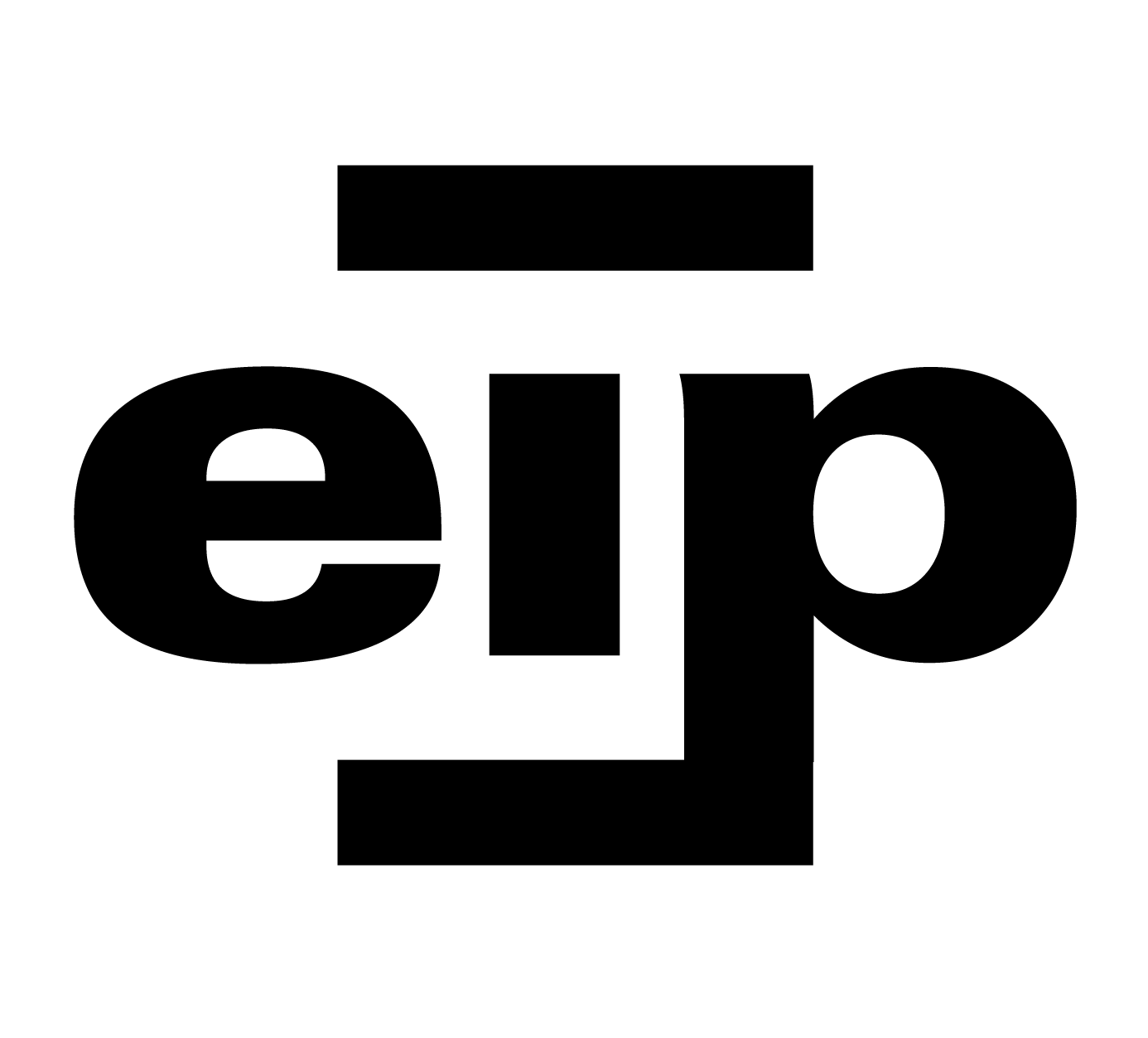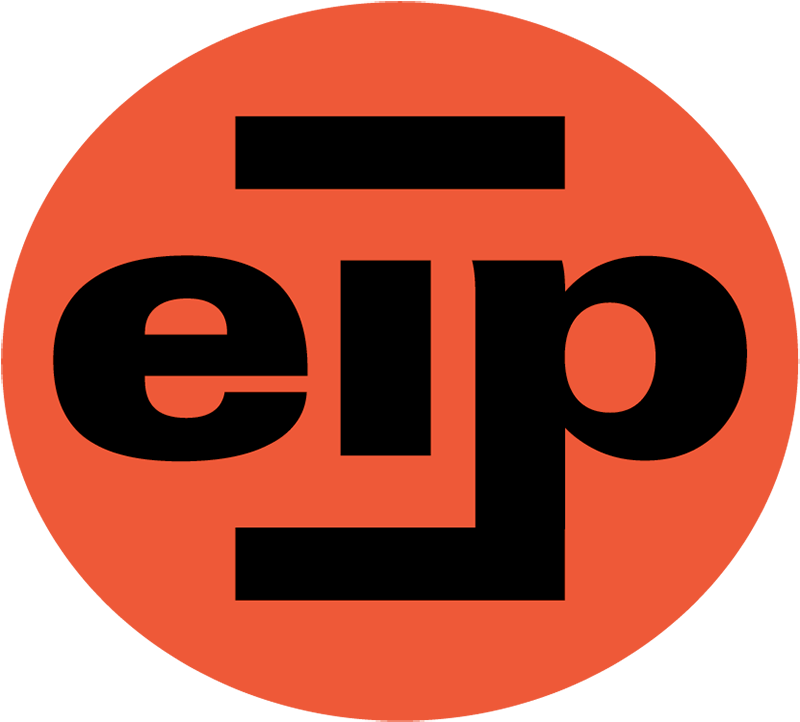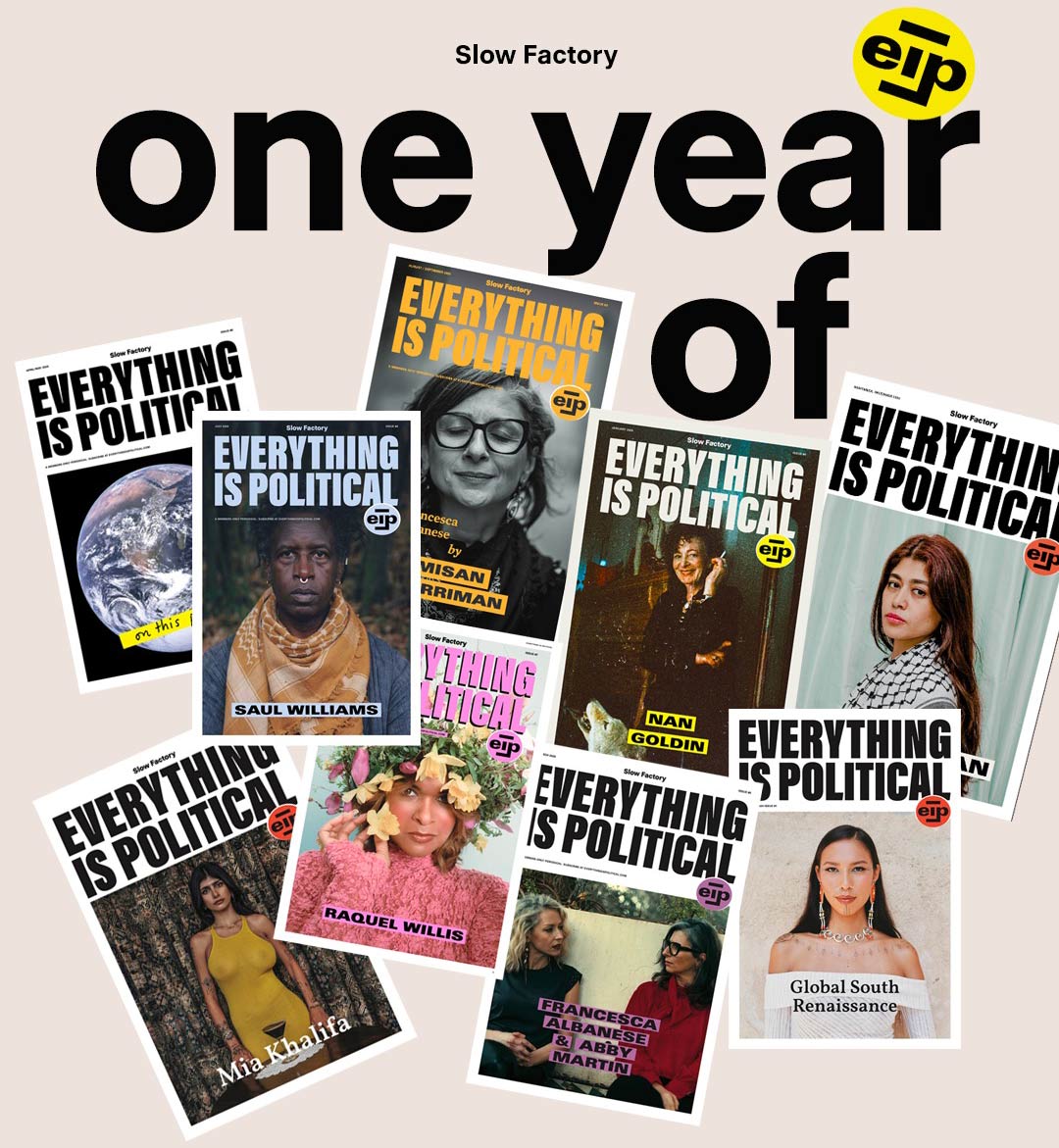Digital & Print Membership
Yearly + Receive 8 free printed back issues
$420 Annually
Monthly + Receive 3 free printed back issues
$40 Monthly
Nepal’s New Reckoning
From September 8-11, 2025, a massive popular uprising has taken place in Nepal, forcing the resignation of the Prime Minister and much of the government. We present some description and first reflections on the protests and riots, which were sparked by a social media ban and anger over government corruption and nepotism.
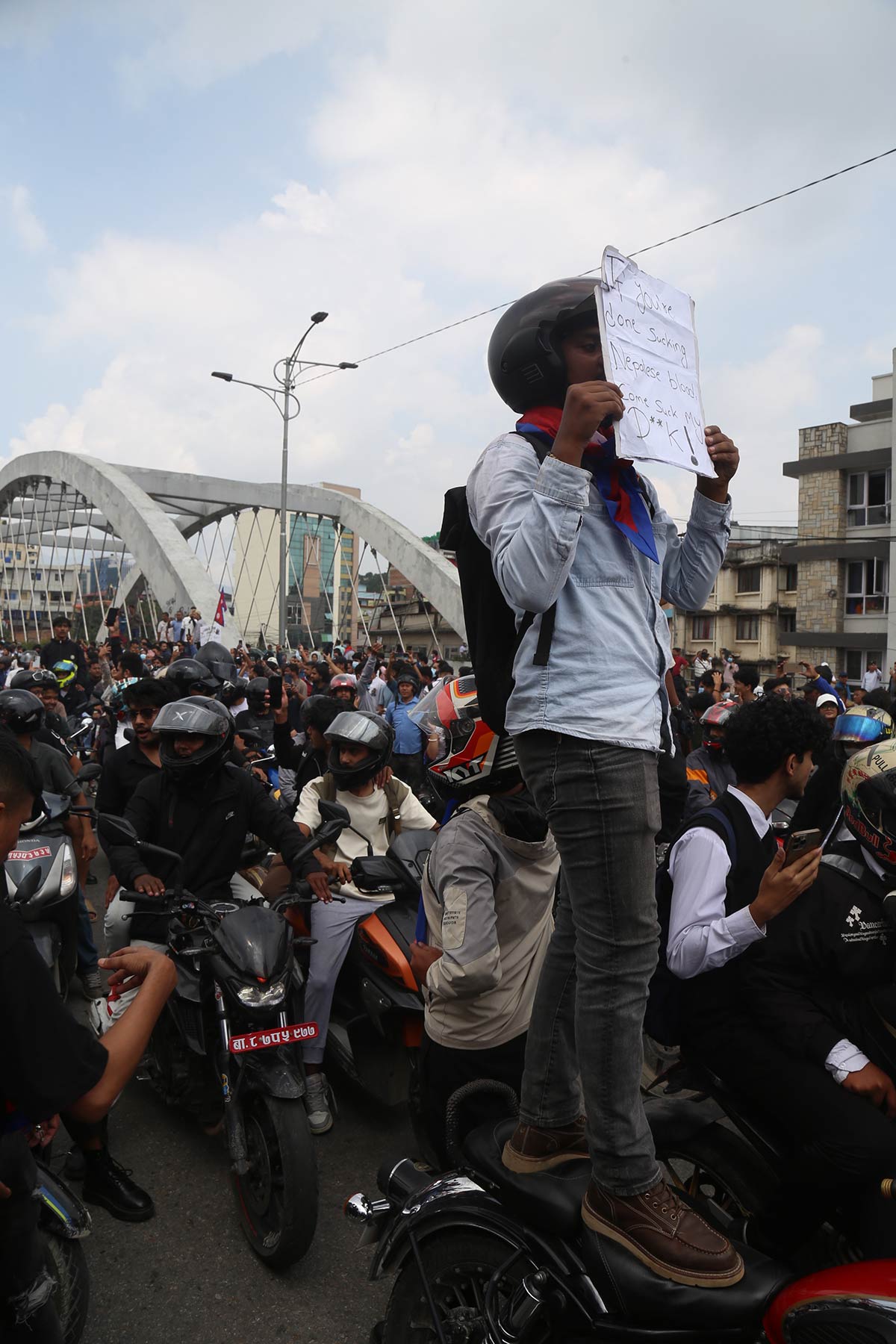
September 8
In the white glare of a late summer morning, the broad avenues of Kathmandu, Nepal’s modern capital, are usually thrumming with traffic and smog. But on this sweltering day, the streets were crowded with chanting protesters, all of them demonstrating against the government of KP Sharma Oli. The largest crowd by far was made up of Gen-Z youth, most in their twenties, many still in school and college uniforms.
For Nepal, such eruptions aren’t new: generations have risen before—against Rana autocrats in the 1950s, against royal rule in 1990, against King Gyanendra’s coup in 2005—only to watch hard-won freedoms erode. But for many of the protestors I spoke to, this was likely their first gathering. Their mission, organised on Instagram, Facebook, and Discord, was grand. They had gathered to protest the dismal state of the country, where the powerful and their children lived in luxury while countless Nepalis laboured abroad in countries like Qatar, Saudi Arabia, and Malaysia, sending remittances home to sustain their families. They marched in loose coordination, some singing protest songs, others dancing to drumbeats, and many chanting slogans. Handmade signs bore slogans carefully daubed in black paint.
The last straw had come days earlier when the government imposed a blanket ban on social media platforms, cutting off main channels through which young Nepalis expressed frustration and organised politically. Tensions were already high, fueled in part by viral chatter about “nepo-babies,” the young faces that have long been symbols of privilege fast-tracked into positions of power because of their family connections. For Nepal’s youth, social media became a stage to mock them, question their merit, and call out a system where politics often feels like a family business.
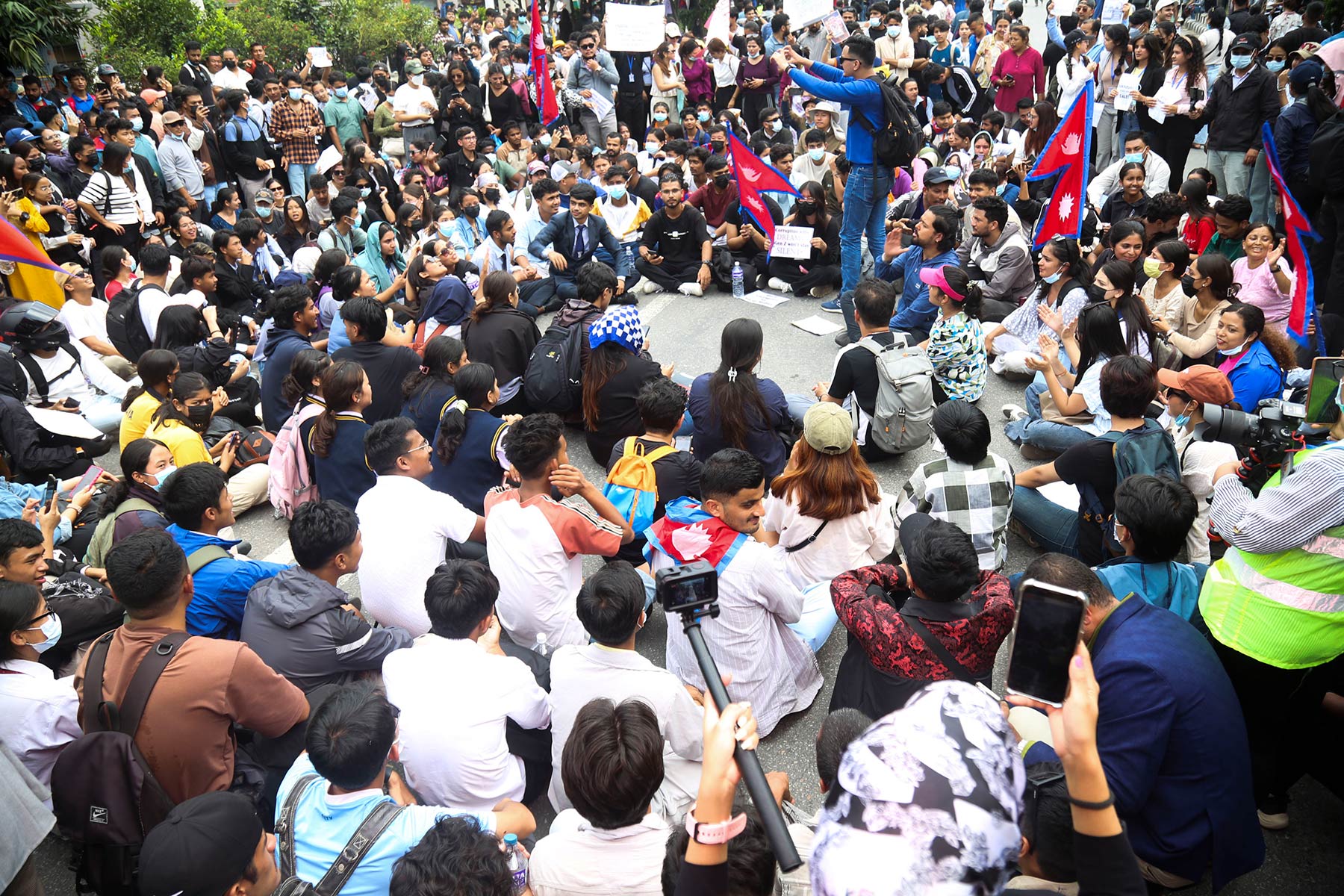
As the protesters pushed past the barricades outside Parliament, the police unexpectedly fell back rather than delivering the usual baton charge. A few tear gas canisters hissed through the air, and a lone water cannon swept the crowd, but the confrontation seemed restrained. People snapped selfies amid the haze, their chants echoing off the old brick walls, and for a brief moment, it felt almost ordinary, as if the protest might remain just another turbulent day in Kathmandu.
According to reports, a cluster of older men mumbled about storming Parliament, while a few young riders, adrenaline surging, tore recklessly through the crowd on motorbikes, shouting insults. Near the complex itself, the energy shifted, protesters began hammering at the outer walls, some scrambling up the gates as flames flickered near the main entrance. The Armed Police Force advanced, their body armour and riot shields glinting under the dimming light, first launching tear gas canisters, then rubber bullets. In moments, the demonstration’s creative, almost celebratory tone disintegrated. Rocks and debris flew back toward the police lines. Gunfire—allegedly live rounds—cracked above the din. Chaos engulfed Kathmandu’s political heart.
Videos soon flooded social media of unarmed students in school uniforms bleeding from head wounds, men collapsing unconscious, and disturbing claims that security forces had even fired tear gas into hospital grounds and beat the injured. What began as students chanting against corruption was quickly slipping into something far more volatile.
By nightfall, nineteen people were dead in Kathmandu—a toll that already exceeded the casualties from Nepal’s 2006 People’s Movement, which had taken nineteen days to claim thirteen lives. Hospitals across the capital struggled with hundreds of injured protesters, many still in school uniforms. Blood banks reported critical shortages as medical staff worked through the night, treating gunshot wounds and head injuries from what had begun, just hours earlier, as a peaceful demonstration. Across the rest of Nepal, deaths and injuries were also reported, though full numbers remain unrecorded as events continue to unfold.
The scale of the violence was unprecedented in Nepal’s modern democratic history. Even during the monarchy’s final, desperate attempts to maintain power nearly two decades earlier, the state had not deployed lethal force with such devastating efficiency against its own citizens. For a generation that had known only the republic, however flawed, the sight of young people bleeding in the streets represented a profound rupture in their understanding of what their government was capable of.
To understand why thousands of teenagers and twenty-somethings would brave tear gas and rubber bullets, one must consider a long history of frustrated hopes for reform. Nearly two decades after the civil war ended, Prachanda, the former Maoist insurgent, once seemed a beacon of change. Millions voted for him, hoping for a fairer voice for the marginalised, a more just Nepal. But hope gave way to compromise, personal gain, and the slow churn of the same familiar leaders. The constitution, progressive on paper, was watered down. A new constitution, progressive in Nepal’s historical context, was stalled and diluted, and subsequent elections delivered a familiar cycle. The same discredited leaders rotating through power, swapped like pieces on a chessboard, their promises of reform fading with each turn.
Public services remain poor. Tax burdens are high. Corruption scandals implicating politicians, bureaucrats, and businessmen piled up like grim milestones in the failure of the state. For decades, Nepal’s elites had looted land, siphoned public funds, and promised reforms that never came, leaving ordinary citizens disillusioned.
It is this long pattern of systemic rot that now fuels the anger spilling onto Kathmandu’s streets—the young protesters demanding, in word and in action, that Nepal finally deliver on the change that generations have been promised but never seen.
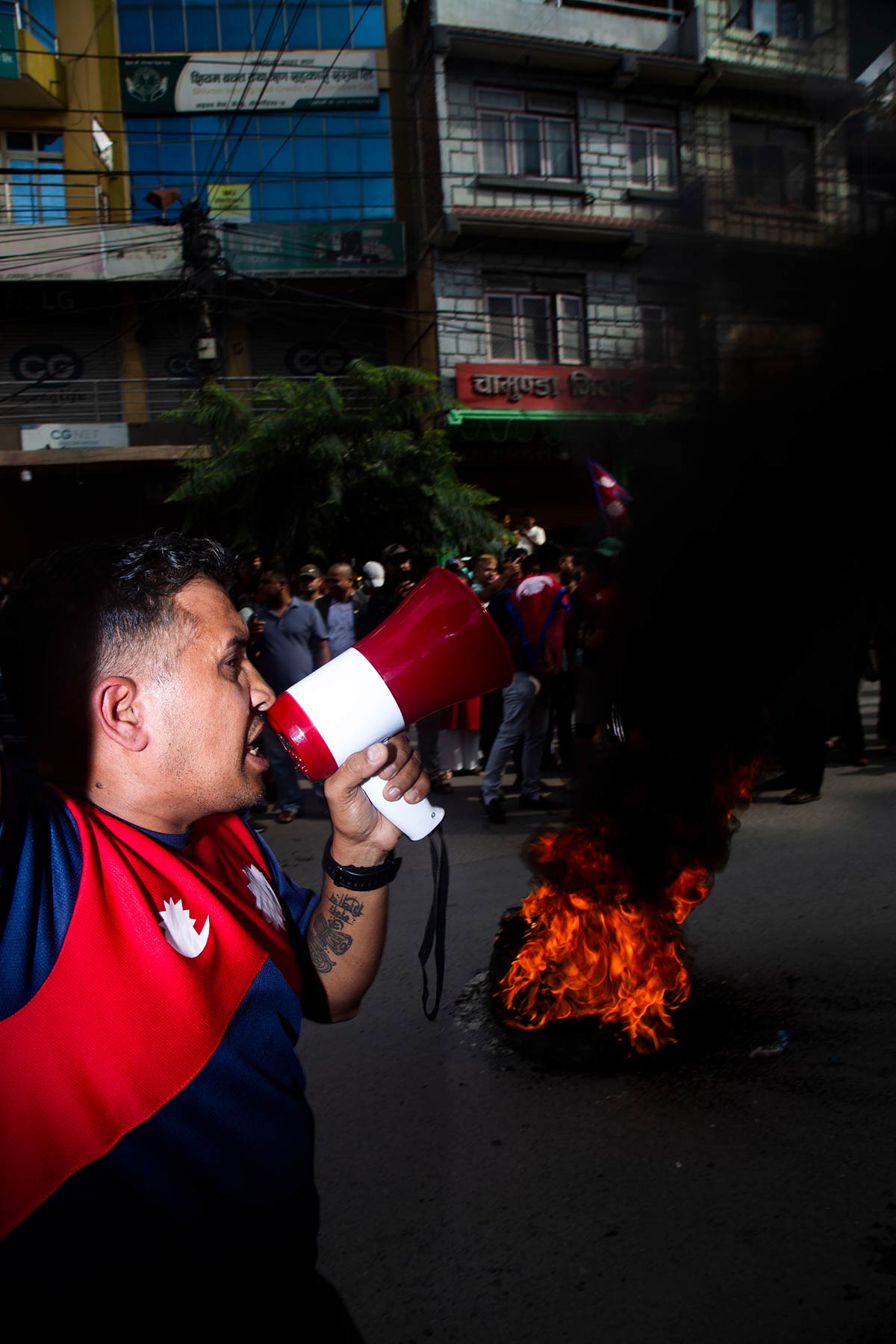
September 9
The smell hit you first—acrid smoke from burning tires laced with petrol, hanging in Kathmandu’s September air like a toxic fog. Dawn on September 9th brought no respite. If anything, the deaths of nineteen protesters had transformed grief into something more volatile. Thousands defied hastily imposed curfews, emerging into streets still lingering with smoke from the previous day’s violence. What had begun as a youth-led movement against corruption now metastasised into something broader and more destructive—an utter rejection of Nepal’s political establishment.
The targets were systematic. Party offices, politicians’ residences, and government buildings all came under attack. By afternoon, thick columns of smoke rose across the Kathmandu Valley, and the tint in the sky shifted from clear blue to a smoky haze that hung over the entire capital. Tribhuvan International Airport suspended operations, diverting flights as the capital descended into chaos. In the newer ministerial quarters south of the city, helicopters shuttled back and forth, evacuating officials in what appeared to be a tacit admission that the government could no longer hold pressure.

The political collapse was swift and total. Ministers resigned in cascading waves, following the home minister, who had tendered his resignation the previous evening. Opposition parliamentarians abandoned their posts en masse, demanding fresh elections. By three o’clock in the afternoon, even K.P. Sharma Oli, in his third stint as prime minister and renowned for his political durability, announced his resignation and fled to Dubai.
But resignation could not restore order. As the day moved, things spiralled completely out of control.
This was no longer the Gen Z protestors of the previous day. In their place, an unruly mob surged through the streets. Outside Singha Durbar, Kathmandu’s sprawling government hub, protesters smashed windows, looted buildings, and seized weapons from the police as they pushed deeper into the complex. In the chaos, prisoners were freed, fires consumed the President’s residence, the Supreme Court alongside Parliament, and police stations burned alongside shops. The line between symbol and target had vanished. In just forty-eight hours, Nepal had witnessed its bloodiest civil unrest in modern memory, and the civilian government had unravelled before the nation’s eyes.
“This is not us,” the Gen-Z groups leading the movement, Hami Nepal, posted on their social media. “Our struggle is for justice, dignity, and a better Nepal, not for chaos and theft.”
Only well into the night, the Army chief appeared, urging restraint and calm. The military would be deployed to restore order.
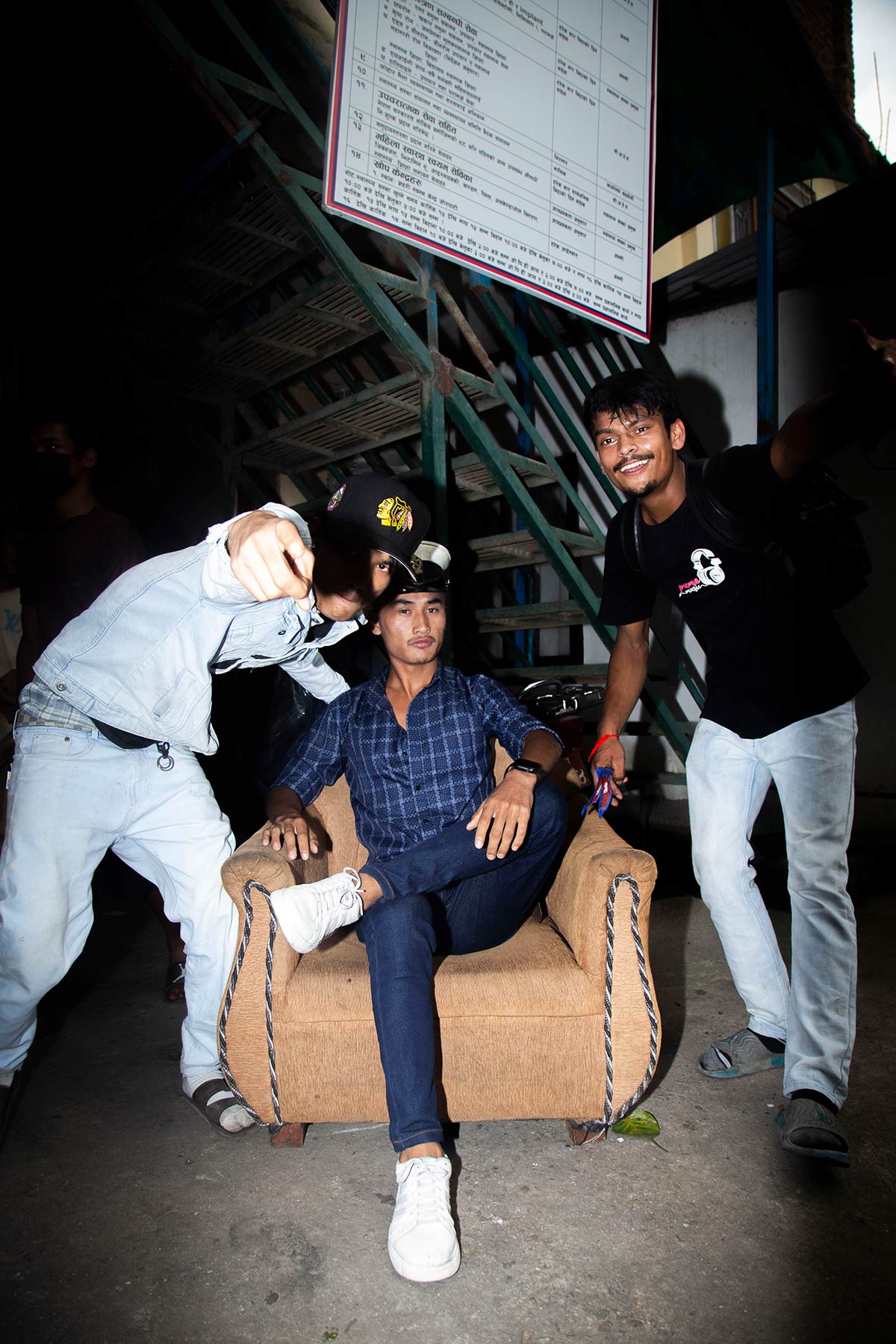
September 10
All this upheaval would have been unimaginable even a month ago.
A heavy, almost unnatural silence hung over the city. Curfew had been imposed, the streets were empty, and the Army patrolled in rigid lines. The roar of burning tires, the chants that shook walls, and the smoke that had choked the air yesterday had faded, leaving only a lingering haze and the metallic tang of uncertainty. Sunlight struggled through the smog, casting the streets in a dim, uneasy glow. The city felt suspended, caught between yesterday’s chaos and whatever tomorrow might bring, and we awoke with nothing but questions and the weight of uncertainty pressing down on every corner.
The Nepal Army still mans checkpoints across Kathmandu, its soldiers stationed at every major intersection. Any gathering of more than a handful of people is broken up, an officer steps forward, offers an unmistakable “move on,” and the cluster dissolves.
Questions hung in the air with the smoke. Who would answer for the bloodshed? Who now held authority? And in the absence of clear leadership, how would life move forward? The deaths of more than thirty protesters could not go unanswered. Yet even among those who had demanded change, the scale of destruction stirred unease. Nobody could say who truly held power, or what would come next.
The revolution’s fever has broken; now comes the harder, less visible work. The only institutions left standing, the Presidency and the Army, have invited Gen-Z representatives to the table to sketch a path forward. But even in these early overtures, the Army’s hand is visible, its preferences for who might lead flickering through measured, strategic negotiation.
Gen-Z in Nepal remains unmoored, bound more by digital fluency than by shared leadership or vision. Amid the chaos of Discord debates and clashing ideas, the movement is experimenting with ways to assert influence in a leaderless uprising. On a bustling Discord server, young protesters held their own vote for an interim leader, selecting Sushila Karki, Nepal’s first female Chief Justice. The proposal followed an extensive discussion on the platform, lasting nearly five hours, where over 10,000 participants shared their opinions. The server buzzed with debate, dissent, and deliberation, a digital agora where ideas clashed and alliances formed, revealing both the potential and uncertainties of a leaderless uprising. Other names, such as Balen Shah, Kathmandu’s independent mayor who rose from rapper to reform-minded politician, and Harka Sampang, Dharan’s grassroots-focused mayor, also surfaced in discussions, signalling the generation’s appetite for leaders who break from the recycled elite and embody accountability, visibility, and boldness. Though no formal appointment has been made, these debates offer a glimpse of a generation seeking new pathways, negotiating authority and vision in real time.
This is the third great convulsion to shake South Asia since 2022—after Sri Lanka and Bangladesh—prompting some observers to whisper of a ‘South-Asian Spring,’ a phrase that carries the echo of the Arab Spring’s long shadow. The Nepali youth-led uprising has even borrowed the aesthetics of dissent from Indonesia as protesters waved the Straw Hat Pirates flag from One Piece, an emblem that has become a shared shorthand for rebellion in both countries. In Bangladesh, Sheikh Hasina’s government fell to similar youth-led protests just months earlier; in Sri Lanka, the 2022 uprising forced out the Rajapaksa dynasty. The same fault line ran across the region, crooked governments, restless citizens, and revolt spread across borders.
Yet across and within these territories, the road ahead remains murky, the outcomes anything but certain. Bangladesh’s interim government struggles to reform entrenched systems. Sri Lanka’s new leadership has already retreated from promises that once stirred hope. These movements have excelled at toppling regimes but have struggled to build lasting alternatives.
Nepal now faces the same daunting test its neighbours have confronted, struggling to turn a swell of popular fury into durable political reform rather than merely swapping one weary cadre of power brokers for another. Whether this generational uprising can finally crack the cycle of disappointment that has long defined South Asian politics, or whether it will join the list of movements that changed everything and nothing at all.
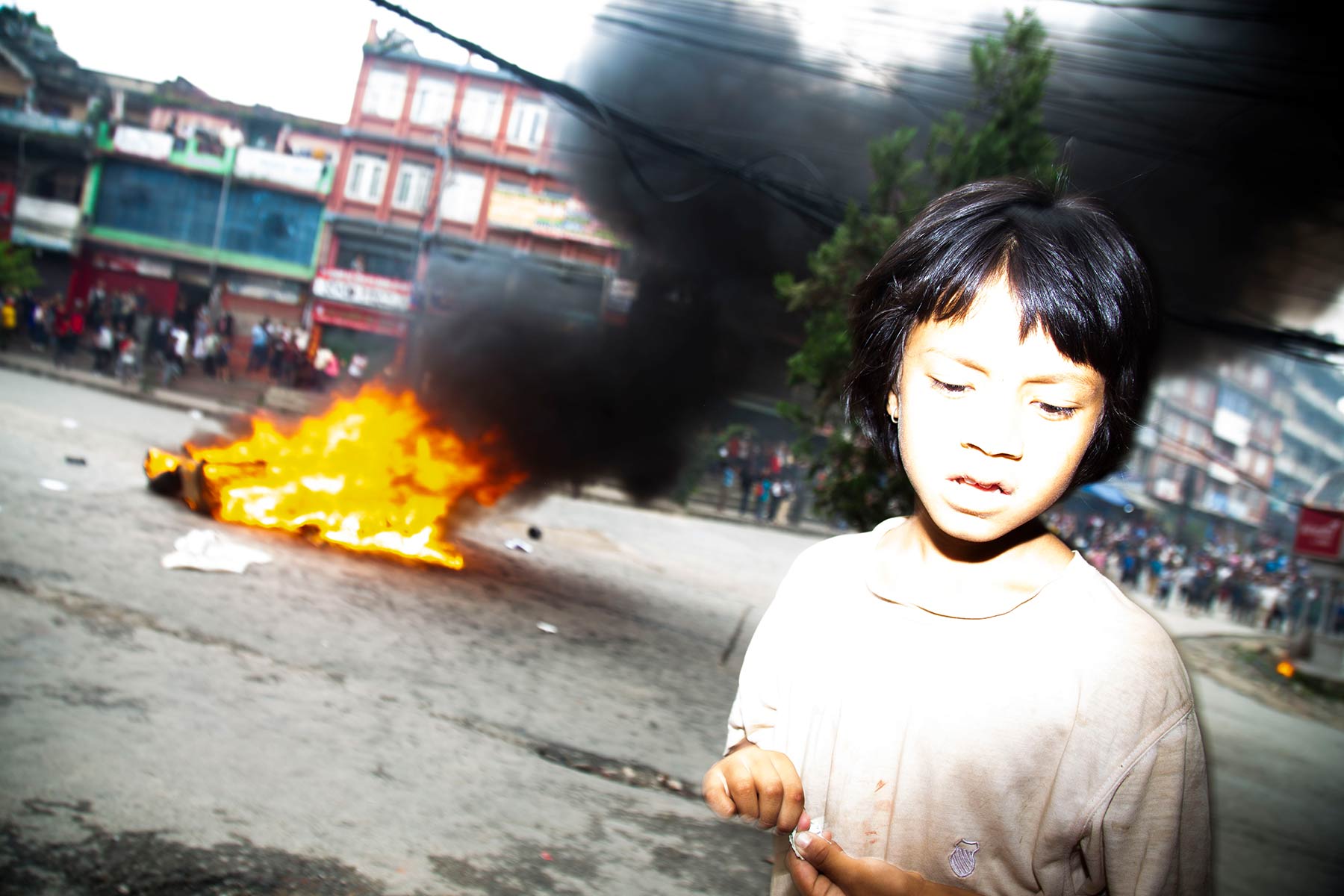
September 11
By Thursday morning, steady rain slicked Kathmandu’s streets, but the scars of upheaval were impossible to miss. Charred cars leaned against curbs, and the husks of looted buildings smouldered faintly under the drizzle. The capital was calm, almost eerily so, yet the quiet felt provisional, like a held breath. With the prime minister and his cabinet gone, Parliament effectively leaderless, and ministries shuttered, Nepal now stands without a functioning civilian government. The President and the Army, the only intact institutions, continue to act as de facto authorities, signalling interest in forming an interim arrangement. The old guard has vanished, leaving a power vacuum that multiple actors with competing interests are eager to fill. Political parties that seemed fractured just days ago are quietly regrouping, issuing statements of solidarity with Gen Z to distance themselves from their past complicity. Opportunists linger in the shadows, hoping to redirect the uprising’s momentum for personal gain. At the same time, misinformation spreads online, clouding clarity and amplifying confusion. Former Chief Justice Sushila Karki is seen as a frontrunner. Still, no consensus has been reached among protest groups, leaving the country in a state of suspended expectation.
The old guard has vanished, leaving a power vacuum that multiple actors with competing interests are eager to fill. Political parties that seemed fractured just days ago are quietly regrouping, issuing statements of solidarity with Gen Z to distance themselves from their past complicity. Opportunists linger in the shadows, hoping to redirect the uprising’s momentum for personal gain. At the same time, misinformation spreads online, clouding clarity and amplifying confusion. After days of silence, Nepal’s President Ram Chandra Paudel issued a statement on Thursday assuring citizens that every effort is being made to navigate the crisis and find a way forward within the constitutional framework. Former Chief Justice Sushila Karki is seen as a frontrunner, but no consensus has been reached among protest groups, leaving the country in a state of suspended expectation.
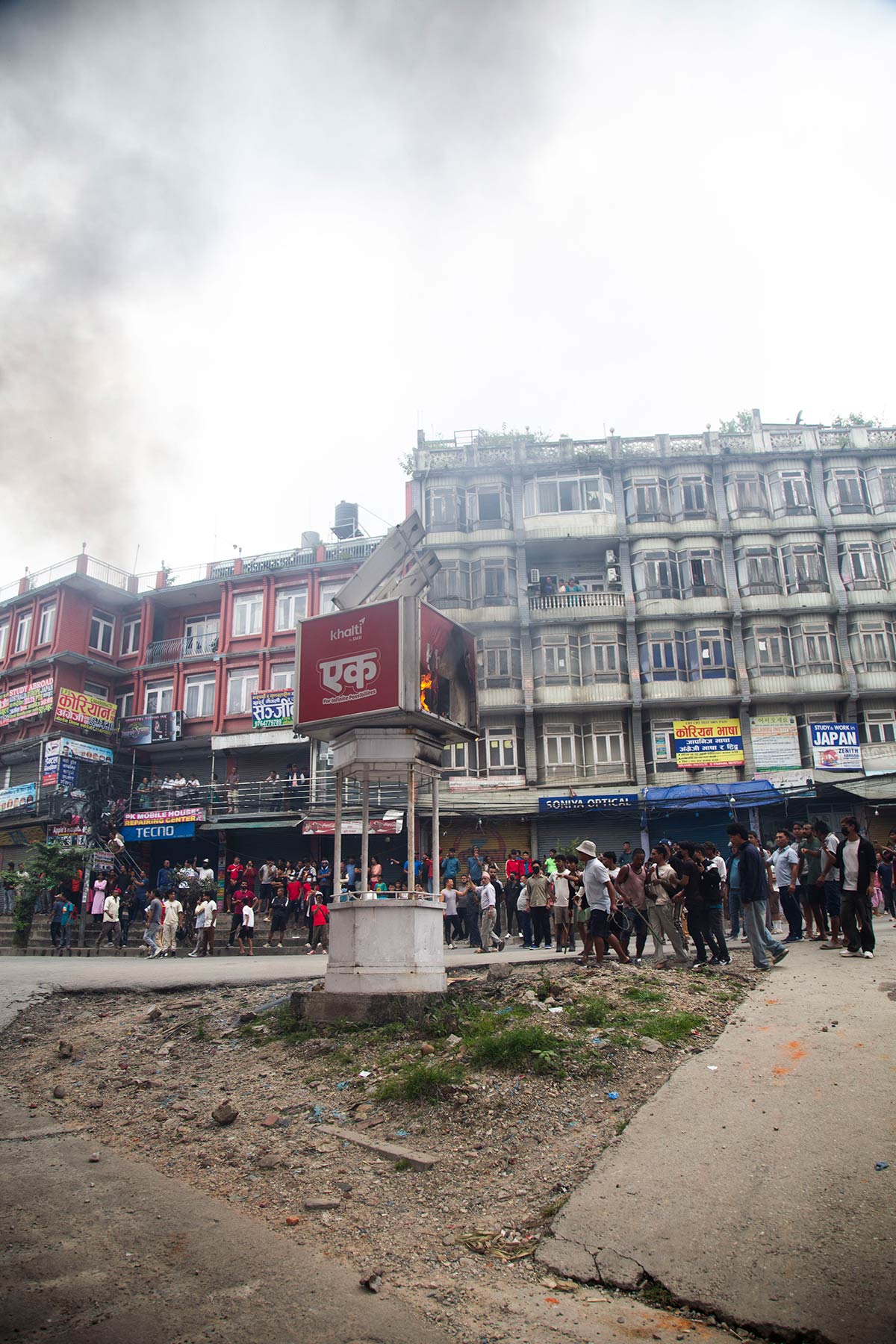
In Conversation:
Photography by:
More from: Tulsi Rauniyar
Keep reading:
Global Echoes of Resistance:
Artists Harnessing Art, Culture, and Ancestry
Yasmin Ali
{
"article":
{
"title" : "Nepal’s New Reckoning",
"author" : "Tulsi Rauniyar",
"category" : "",
"url" : "https://everythingispolitical.com/readings/nepal-reckoning",
"date" : "2025-09-11 18:11:00 -0400",
"img" : "https://everythingispolitical.com/uploads/nepal1-IMG_5694.jpg",
"excerpt" : "From September 8-11, 2025, a massive popular uprising has taken place in Nepal, forcing the resignation of the Prime Minister and much of the government. We present some description and first reflections on the protests and riots, which were sparked by a social media ban and anger over government corruption and nepotism.",
"content" : "From September 8-11, 2025, a massive popular uprising has taken place in Nepal, forcing the resignation of the Prime Minister and much of the government. We present some description and first reflections on the protests and riots, which were sparked by a social media ban and anger over government corruption and nepotism.September 8In the white glare of a late summer morning, the broad avenues of Kathmandu, Nepal’s modern capital, are usually thrumming with traffic and smog. But on this sweltering day, the streets were crowded with chanting protesters, all of them demonstrating against the government of KP Sharma Oli. The largest crowd by far was made up of Gen-Z youth, most in their twenties, many still in school and college uniforms.For Nepal, such eruptions aren’t new: generations have risen before—against Rana autocrats in the 1950s, against royal rule in 1990, against King Gyanendra’s coup in 2005—only to watch hard-won freedoms erode. But for many of the protestors I spoke to, this was likely their first gathering. Their mission, organised on Instagram, Facebook, and Discord, was grand. They had gathered to protest the dismal state of the country, where the powerful and their children lived in luxury while countless Nepalis laboured abroad in countries like Qatar, Saudi Arabia, and Malaysia, sending remittances home to sustain their families. They marched in loose coordination, some singing protest songs, others dancing to drumbeats, and many chanting slogans. Handmade signs bore slogans carefully daubed in black paint.The last straw had come days earlier when the government imposed a blanket ban on social media platforms, cutting off main channels through which young Nepalis expressed frustration and organised politically. Tensions were already high, fueled in part by viral chatter about “nepo-babies,” the young faces that have long been symbols of privilege fast-tracked into positions of power because of their family connections. For Nepal’s youth, social media became a stage to mock them, question their merit, and call out a system where politics often feels like a family business.As the protesters pushed past the barricades outside Parliament, the police unexpectedly fell back rather than delivering the usual baton charge. A few tear gas canisters hissed through the air, and a lone water cannon swept the crowd, but the confrontation seemed restrained. People snapped selfies amid the haze, their chants echoing off the old brick walls, and for a brief moment, it felt almost ordinary, as if the protest might remain just another turbulent day in Kathmandu.According to reports, a cluster of older men mumbled about storming Parliament, while a few young riders, adrenaline surging, tore recklessly through the crowd on motorbikes, shouting insults. Near the complex itself, the energy shifted, protesters began hammering at the outer walls, some scrambling up the gates as flames flickered near the main entrance. The Armed Police Force advanced, their body armour and riot shields glinting under the dimming light, first launching tear gas canisters, then rubber bullets. In moments, the demonstration’s creative, almost celebratory tone disintegrated. Rocks and debris flew back toward the police lines. Gunfire—allegedly live rounds—cracked above the din. Chaos engulfed Kathmandu’s political heart.Videos soon flooded social media of unarmed students in school uniforms bleeding from head wounds, men collapsing unconscious, and disturbing claims that security forces had even fired tear gas into hospital grounds and beat the injured. What began as students chanting against corruption was quickly slipping into something far more volatile.By nightfall, nineteen people were dead in Kathmandu—a toll that already exceeded the casualties from Nepal’s 2006 People’s Movement, which had taken nineteen days to claim thirteen lives. Hospitals across the capital struggled with hundreds of injured protesters, many still in school uniforms. Blood banks reported critical shortages as medical staff worked through the night, treating gunshot wounds and head injuries from what had begun, just hours earlier, as a peaceful demonstration. Across the rest of Nepal, deaths and injuries were also reported, though full numbers remain unrecorded as events continue to unfold.The scale of the violence was unprecedented in Nepal’s modern democratic history. Even during the monarchy’s final, desperate attempts to maintain power nearly two decades earlier, the state had not deployed lethal force with such devastating efficiency against its own citizens. For a generation that had known only the republic, however flawed, the sight of young people bleeding in the streets represented a profound rupture in their understanding of what their government was capable of.To understand why thousands of teenagers and twenty-somethings would brave tear gas and rubber bullets, one must consider a long history of frustrated hopes for reform. Nearly two decades after the civil war ended, Prachanda, the former Maoist insurgent, once seemed a beacon of change. Millions voted for him, hoping for a fairer voice for the marginalised, a more just Nepal. But hope gave way to compromise, personal gain, and the slow churn of the same familiar leaders. The constitution, progressive on paper, was watered down. A new constitution, progressive in Nepal’s historical context, was stalled and diluted, and subsequent elections delivered a familiar cycle. The same discredited leaders rotating through power, swapped like pieces on a chessboard, their promises of reform fading with each turn.Public services remain poor. Tax burdens are high. Corruption scandals implicating politicians, bureaucrats, and businessmen piled up like grim milestones in the failure of the state. For decades, Nepal’s elites had looted land, siphoned public funds, and promised reforms that never came, leaving ordinary citizens disillusioned.It is this long pattern of systemic rot that now fuels the anger spilling onto Kathmandu’s streets—the young protesters demanding, in word and in action, that Nepal finally deliver on the change that generations have been promised but never seen.September 9The smell hit you first—acrid smoke from burning tires laced with petrol, hanging in Kathmandu’s September air like a toxic fog. Dawn on September 9th brought no respite. If anything, the deaths of nineteen protesters had transformed grief into something more volatile. Thousands defied hastily imposed curfews, emerging into streets still lingering with smoke from the previous day’s violence. What had begun as a youth-led movement against corruption now metastasised into something broader and more destructive—an utter rejection of Nepal’s political establishment.The targets were systematic. Party offices, politicians’ residences, and government buildings all came under attack. By afternoon, thick columns of smoke rose across the Kathmandu Valley, and the tint in the sky shifted from clear blue to a smoky haze that hung over the entire capital. Tribhuvan International Airport suspended operations, diverting flights as the capital descended into chaos. In the newer ministerial quarters south of the city, helicopters shuttled back and forth, evacuating officials in what appeared to be a tacit admission that the government could no longer hold pressure.The political collapse was swift and total. Ministers resigned in cascading waves, following the home minister, who had tendered his resignation the previous evening. Opposition parliamentarians abandoned their posts en masse, demanding fresh elections. By three o’clock in the afternoon, even K.P. Sharma Oli, in his third stint as prime minister and renowned for his political durability, announced his resignation and fled to Dubai.But resignation could not restore order. As the day moved, things spiralled completely out of control.This was no longer the Gen Z protestors of the previous day. In their place, an unruly mob surged through the streets. Outside Singha Durbar, Kathmandu’s sprawling government hub, protesters smashed windows, looted buildings, and seized weapons from the police as they pushed deeper into the complex. In the chaos, prisoners were freed, fires consumed the President’s residence, the Supreme Court alongside Parliament, and police stations burned alongside shops. The line between symbol and target had vanished. In just forty-eight hours, Nepal had witnessed its bloodiest civil unrest in modern memory, and the civilian government had unravelled before the nation’s eyes.“This is not us,” the Gen-Z groups leading the movement, Hami Nepal, posted on their social media. “Our struggle is for justice, dignity, and a better Nepal, not for chaos and theft.”Only well into the night, the Army chief appeared, urging restraint and calm. The military would be deployed to restore order.September 10All this upheaval would have been unimaginable even a month ago.A heavy, almost unnatural silence hung over the city. Curfew had been imposed, the streets were empty, and the Army patrolled in rigid lines. The roar of burning tires, the chants that shook walls, and the smoke that had choked the air yesterday had faded, leaving only a lingering haze and the metallic tang of uncertainty. Sunlight struggled through the smog, casting the streets in a dim, uneasy glow. The city felt suspended, caught between yesterday’s chaos and whatever tomorrow might bring, and we awoke with nothing but questions and the weight of uncertainty pressing down on every corner.The Nepal Army still mans checkpoints across Kathmandu, its soldiers stationed at every major intersection. Any gathering of more than a handful of people is broken up, an officer steps forward, offers an unmistakable “move on,” and the cluster dissolves.Questions hung in the air with the smoke. Who would answer for the bloodshed? Who now held authority? And in the absence of clear leadership, how would life move forward? The deaths of more than thirty protesters could not go unanswered. Yet even among those who had demanded change, the scale of destruction stirred unease. Nobody could say who truly held power, or what would come next.The revolution’s fever has broken; now comes the harder, less visible work. The only institutions left standing, the Presidency and the Army, have invited Gen-Z representatives to the table to sketch a path forward. But even in these early overtures, the Army’s hand is visible, its preferences for who might lead flickering through measured, strategic negotiation.Gen-Z in Nepal remains unmoored, bound more by digital fluency than by shared leadership or vision. Amid the chaos of Discord debates and clashing ideas, the movement is experimenting with ways to assert influence in a leaderless uprising. On a bustling Discord server, young protesters held their own vote for an interim leader, selecting Sushila Karki, Nepal’s first female Chief Justice. The proposal followed an extensive discussion on the platform, lasting nearly five hours, where over 10,000 participants shared their opinions. The server buzzed with debate, dissent, and deliberation, a digital agora where ideas clashed and alliances formed, revealing both the potential and uncertainties of a leaderless uprising. Other names, such as Balen Shah, Kathmandu’s independent mayor who rose from rapper to reform-minded politician, and Harka Sampang, Dharan’s grassroots-focused mayor, also surfaced in discussions, signalling the generation’s appetite for leaders who break from the recycled elite and embody accountability, visibility, and boldness. Though no formal appointment has been made, these debates offer a glimpse of a generation seeking new pathways, negotiating authority and vision in real time.This is the third great convulsion to shake South Asia since 2022—after Sri Lanka and Bangladesh—prompting some observers to whisper of a ‘South-Asian Spring,’ a phrase that carries the echo of the Arab Spring’s long shadow. The Nepali youth-led uprising has even borrowed the aesthetics of dissent from Indonesia as protesters waved the Straw Hat Pirates flag from One Piece, an emblem that has become a shared shorthand for rebellion in both countries. In Bangladesh, Sheikh Hasina’s government fell to similar youth-led protests just months earlier; in Sri Lanka, the 2022 uprising forced out the Rajapaksa dynasty. The same fault line ran across the region, crooked governments, restless citizens, and revolt spread across borders.Yet across and within these territories, the road ahead remains murky, the outcomes anything but certain. Bangladesh’s interim government struggles to reform entrenched systems. Sri Lanka’s new leadership has already retreated from promises that once stirred hope. These movements have excelled at toppling regimes but have struggled to build lasting alternatives.Nepal now faces the same daunting test its neighbours have confronted, struggling to turn a swell of popular fury into durable political reform rather than merely swapping one weary cadre of power brokers for another. Whether this generational uprising can finally crack the cycle of disappointment that has long defined South Asian politics, or whether it will join the list of movements that changed everything and nothing at all.September 11By Thursday morning, steady rain slicked Kathmandu’s streets, but the scars of upheaval were impossible to miss. Charred cars leaned against curbs, and the husks of looted buildings smouldered faintly under the drizzle. The capital was calm, almost eerily so, yet the quiet felt provisional, like a held breath. With the prime minister and his cabinet gone, Parliament effectively leaderless, and ministries shuttered, Nepal now stands without a functioning civilian government. The President and the Army, the only intact institutions, continue to act as de facto authorities, signalling interest in forming an interim arrangement. The old guard has vanished, leaving a power vacuum that multiple actors with competing interests are eager to fill. Political parties that seemed fractured just days ago are quietly regrouping, issuing statements of solidarity with Gen Z to distance themselves from their past complicity. Opportunists linger in the shadows, hoping to redirect the uprising’s momentum for personal gain. At the same time, misinformation spreads online, clouding clarity and amplifying confusion. Former Chief Justice Sushila Karki is seen as a frontrunner. Still, no consensus has been reached among protest groups, leaving the country in a state of suspended expectation.The old guard has vanished, leaving a power vacuum that multiple actors with competing interests are eager to fill. Political parties that seemed fractured just days ago are quietly regrouping, issuing statements of solidarity with Gen Z to distance themselves from their past complicity. Opportunists linger in the shadows, hoping to redirect the uprising’s momentum for personal gain. At the same time, misinformation spreads online, clouding clarity and amplifying confusion. After days of silence, Nepal’s President Ram Chandra Paudel issued a statement on Thursday assuring citizens that every effort is being made to navigate the crisis and find a way forward within the constitutional framework. Former Chief Justice Sushila Karki is seen as a frontrunner, but no consensus has been reached among protest groups, leaving the country in a state of suspended expectation."
}
,
"relatedposts": [
{
"title" : "Narrative Sovereignty in the American Wing of The Met: Don't Miss ENCODED at the MET",
"author" : "",
"category" : "",
"url" : "https://everythingispolitical.com/readings/narrative-sovereignty-in-the-american-wing-of-the-met",
"date" : "2025-12-22 12:58:00 -0500",
"img" : "https://everythingispolitical.com/uploads/Cover_EIP_Hidden_Exhibition.jpg",
"excerpt" : "As artists and multicultural activists, we did not come to the Metropolitan Museum of Art’s American Wing seeking permission, instead we showed up to the work with intention, responsibility, and a commitment to truth. ENCODED: Change the Story, Change the Future exists because silence is not neutral, presence without agency is insufficient and solidarity across values-based creativity is essential for liberation.",
"content" : "As artists and multicultural activists, we did not come to the Metropolitan Museum of Art’s American Wing seeking permission, instead we showed up to the work with intention, responsibility, and a commitment to truth. ENCODED: Change the Story, Change the Future exists because silence is not neutral, presence without agency is insufficient and solidarity across values-based creativity is essential for liberation.The American Wing is often described as a celebration of American art, yet it also functions as a carefully curated archive of colonial mythology and westward expansion propaganda. Its paintings and sculptures rehearse familiar narratives: conquest framed as destiny, extraction framed as progress, whiteness framed as purity, Indigenous absence framed as inevitability. These works are not merely historical artifacts; they are instruments of narrative power. They encode ideas about belonging, legitimacy, and nationhood, ideas that continue to shape cultural consciousness and public policy today. ENCODED intervenes in this institutional space not to negate history, but to complicate it. Using augmented reality, the exhibition overlays Indigenous artistic expression and counter-narratives directly onto famous works in the American Wing, reframing them through Indigenous epistemologies, lived experience, and historical truth. This is not an act of erasure. It is an act of expansion and an overt insistence that American art history is incomplete without Indigenous voice, presence, and critique.At its core, ENCODED is grounded in the principle of narrative sovereignty. Narrative sovereignty asserts that communities most impacted by historical and ongoing harm such as Indigenous peoples, Afro-descendant people, Palestinians, Pacific Islanders, Trans folks and the working class all must have the authority to tell their own stories, in their own words, and within the institutions that have historically excluded or misrepresented them. This is not a symbolic gesture. It is a democratic imperative.Democracy depends on access to truth. When museums present a singular, sanitized vision of history, they do not merely reflect power, they reinforce it. The American Wing has long upheld myths of “taming the West” and the so-called exhaustion of empire, narratives that obscure the violence of settler colonialism, normalize Indigenous dispossession and chattel slavery. ENCODED challenges these myths by making visible what has been omitted: resistance, survival, continuity, solidarity and accountability. For me, I also hope this intervention reflects back to museum goers and viewers the perils of authoritarianism, fascism and ongoing colonial projects such as legacy media consolidation, rapid creation of datacenters to produce AI, cutting access to healthcare, education, rights, or the current US regime’s attempt to erase history by any means necessary.The artists participating in ENCODED are not responding nostalgically to the past. They are engaging the present. Their work examines how colonial narratives persist in contemporary systems including environmental destruction justified by extraction, racial hierarchies reinforced through cultural storytelling, and institutions that benefit from the aesthetics of inclusion while resisting structural change. These are not abstract critiques; they are lived realities and for me deep lessons that have been shaped by having formerly worked at a neocolonial conservation nonprofit ran by wealthy cis wyt men and their enablers for nearly five years.Artistic integrity, in this context, cannot be separated from ethical responsibility. For too long, the art world has upheld a false binary between aesthetics and politics, suggesting that rigor diminishes when artists engage power directly. ENCODED rejects this premise. Integrity is not neutrality. Integrity is the willingness to tell the truth, even when it destabilizes comfort or prestige. Walking with integrity can be painful and takes courage.Importantly, ENCODED is not positioned as a protest staged outside the institution, nor as a request for institutional validation. It is an act of presence with agency. The project uses accessible technology to meet audiences where they are, inviting participation rather than reverence. Viewers scan QR codes and encounter layered narratives that ask them to look again, listen differently, and question inherited assumptions. Except for a few organized tours, the experience is self-guided, decentralized, and deliberately democratic. It’s also fun, and it is so special to hear the familiar sounds from the ENCODED pieces ring throughout the galleries signalling that kin is close by.This kinship network and accessibility is central to the work. Cultural literacy should not be gated by academic language, curatorial authority, white exceptionalism or economic privilege. By operating through personal devices, ENCODED rejects the museum’s traditional hierarchy of knowledge and affirms that interpretation is a shared civic space. The exhibition does not dictate conclusions; it creates conditions for reckoning and deep dialogue.Solidarity is another foundational principle of the project. ENCODED brings together Indigenous artists across nations and disciplines, in relationship with Black, Brown, and allied communities who recognize that colonialism is not a single-issue structure. The logics that dispossessed Indigenous peoples are the same logics that underwrote slavery, environmental exploitation, the seizing of Palestine, forced child mining labor of cobalt in Congo and in general global empire. Working in solidarity does not collapse difference; it honors specificity while resisting division and acknowledging historic patterns of systemic oppression.In a cultural landscape shaped by scarcity and competition, ENCODED models an alternative, one rooted in collective presence, shared resources, and mutual accountability. The project refuses the extractive norms of both empire and the contemporary art economy, offering instead a relational approach grounded in care, collaboration, and long-term impact on community.The decision to situate ENCODED within the American Wing was deliberate. Indigenous art has too often been confined to anthropological contexts or framed as premodern, separate from the narrative of American art. ENCODED asserts what has always been true: Indigenous peoples are not peripheral to American history; we are foundational to it. Our stories do not belong on the margins, nor do they belong solely to the past or through a white gaze.Yet presence without counter-narrative risks assimilation. ENCODED insists that visibility must be accompanied by authorship. By intervening directly within the American Wing, the project challenges the authority of colonial framing and invites institutions to reckon with their role in shaping public memory. Our hope is that eventually the Met will see this as an opportunity to engage in discussion and support its presence well into 2026.There is risk in this work. Naming colonial propaganda within revered institutions invites discomfort, defensiveness, and critique. But risk is inseparable from integrity. Artists and cultural workers are accountable not only to institutions and audiences, but to future generations. The question is not whether institutions will change, but whether artists will continue to lead with courage when they do not.ENCODED is an offering and a provocation. It asks what it means to inherit a cultural legacy and whether we are willing to transform it. Empire is not exhausted; it is contested. And art remains one of the most powerful sites of that contestation. When we change the story, we do change the future. Not through erasure, but through expansion. Not through dominance, but through relationship.Ultimately, ENCODED affirms that art is not merely a reflection of society, but a tool for shaping it and that when artists from the margins claim space at the center, together and with integrity, we open pathways toward a more honest, inclusive, and democratic cultural future. Join us.To access ENCODED review the exhibit website for instructions. While at the Met scan the QR code and click through the prompts for the self guided tour.https://www.encodedatthemet.com"
}
,
{
"title" : "The Aesthetics of Atrocity: Lockheed Martin’s Streetwear Pivot",
"author" : "Louis Pisano",
"category" : "",
"url" : "https://everythingispolitical.com/readings/the-aesthetics-of-atrocity",
"date" : "2025-12-20 10:30:00 -0500",
"img" : "https://everythingispolitical.com/uploads/Cover_EIP_Lockheed_StreetWar.jpg",
"excerpt" : "On December 12, The Business of Fashion published an article titled “The Unlikely Rise and Uncertain Future of Lockheed Martin Streetwear,” detailing the world’s largest arms manufacturer’s entrance into casual apparel.",
"content" : "On December 12, The Business of Fashion published an article titled “The Unlikely Rise and Uncertain Future of Lockheed Martin Streetwear,” detailing the world’s largest arms manufacturer’s entrance into casual apparel.Through a licensing deal with South Korea’s Doojin Yanghang Corp., Lockheed turns fighter jet graphics, corporate slogans, and its star logo into gorpcore staples. Oversized outerwear, tactical pants, and advanced synthetic fabrics sell out at Seoul pop-ups like the Hyundai department store with young Korean consumers chasing the edgy, functional vibe. Andy Koh, a Seoul-based content creator, tells BoF that while arms manufacturing is, in theory, political, he has never encountered widespread discomfort among Korean consumers. “As long as it looks cool and the product functions as expected,” he says, “they seem okay with it.”This trend aligns with a broader South Korean fashion phenomenon: licensing logos from global non-fashion brands to create popular streetwear lines. Examples include National Geographic puffers, Yale crewnecks, Kodak retro tees, CNN hoodies, Discovery jackets, Jeep outdoor wear, and university apparel from institutions like Harvard and UCLA. These licensed collections, often featuring media, academia, sports leagues, or adventure themes, have become staples on online retailers like Musinsa and in brick-and-mortar stores, propelled by K-pop influence and a tech-savvy youth market that make these odd crossovers multimillion-dollar successes.Lockheed, however, is categorically different. Its core business is not exploration, education, or journalism. It is industrialized death, and its arrival in fashion forces a reckoning with how far commodification can stretch.Having spent years in the military, maybe I’m the wrong person to critique this. Or maybe I’m exactly the right one. I know what weapons are for, how they’re used, and the human cost they carry. Lockheed manufactures F-16 and F-35 fighter jets, Hellfire missiles, and precision-guided systems that human rights organizations have repeatedly linked to civilian casualties across multiple conflicts. In Yemen, U.S.-supplied weapons incorporating Lockheed technology contributed to thousands of civilian deaths since 2015, most notoriously the 2018 airstrike on a school bus in Saada that killed dozens of children. In Gaza, since October 2023, Lockheed-supplied F-35s and munitions have formed the backbone of air operations that Amnesty International and other watchdogs have flagged for potential violations of international humanitarian law, cases now under examination by the International Court of Justice.In 2024, the company reported $71 billion in revenue, almost entirely from military contracts, with more than 1,100 F-35s already delivered worldwide and production lines running hotter than ever. That staggering scale is the reality lurking beneath a logo now casually printed on everyday apparel.So why does the planet’s largest arms manufacturer license its brand to streetwear? The answer seems to be twofold: easy money and sophisticated image laundering. Licensing delivers low-risk royalties from Korea’s reported $35-40 billion apparel market with virtually no operational headache. Lockheed simply collects checks while a third-party manufacturer handles design, production, distribution, and deals with all the mess of retail.The far more ambitious goal, however, is reputational refurbishment. Doojin deliberately markets the line around “future-oriented technical aesthetics” and “aerospace innovation,” leaning on cutting-edge fabrics to conjure high-tech futurism instead of battlefield carnage. By late 2025, as U.S. favorability in South Korea continued to slide amid trade tensions and regional geopolitical shifts, the brand quietly de-emphasized its American roots, according to Lockheed representatives. The strategy clearly tries to sever the logo from political controversy and plant it firmly in youth culture, where aesthetic appeal routinely outmuscles ethical concern.Lockheed has honed this kind of rebranding for decades. Their corporate brochures overflow with talk of “driving innovation” and “advancing scientific discovery,” spotlighting STEM scholarships, veteran hiring initiatives, and rapid-response disaster aid. The clothing itself carries the same sanitized messaging. One prominent slogan reads “Ensuring those we serve always stay ahead of ready”, euphemistic corporate-speak that sounds heroic until you remember that “those we serve” includes forces deploying Hellfire missiles against civilian targets. Other pieces feature F-35 graphics paired with copy declaring the jet “strengthens national security, enhances global partnerships, and powers economic growth”. It’s textbook PR varnish. Instruments designed for lethal efficiency, now rebranded as symbols of progress and prosperity.We’ve also seen this trick before: Fast fashion brands that slap “sustainable” labels on sweatshop products. Tech giants that fund glamorous art installations while they harvest user data. Oil companies that rebrand themselves as forward-thinking “energy” players as the Earth’s climate burns. Lockheed, though, traffics in something uniquely irreversible: export-grade death. By licensing its identity to apparel, multibillion-dollar arms contracts are reduced to mere intellectual property; civilian casualties dissolved into, simply, background static.In other words, vibes overpower victims. And when those vibes are stamped with the logo of the planet’s preeminent death merchant, resistance feels futile.Gorpcore has always drawn from military surplus for its rugged utility: endless cargo pockets, indestructible nylons, tactical silhouettes born in combat and repurposed for city streets. Brands like Arc’teryx, The North Face, and Supreme mine that heritage for authenticity and performance. After World War II, army fatigues became symbols of genuine rebellion, worn by anti-war protesters as an act of defiance against the establishment. Today, the dynamic threatens to invert entirely. The establishment itself, the world’s preeminent arms dealer, now supplies the “authentic” merchandise, turning subversion into subtle endorsement.Streetwear grew out of skate culture, hip-hop, and grassroots rebellion against mainstream norms. Importing the aesthetics of atrocity risks converting that legacy into compliance, rendering militarism the newest version of mainstream cool. For a generation immersed in filtered feeds and rapid trend cycles, Lockheed’s logo can sit comfortably beside NASA patches or National Geographic emblems, conveniently severed from the charred wreckage in Saada or the devastation in Gaza. Research on “ethical fading” demonstrates how strong visual design can mute moral alarms, a phenomenon intensified in Korea’s hyper-trendy ecosystem, where mandatory military service may further desensitize young consumers to defense branding while K-pop’s global engine drives relentless consumption.If the line proves durable, escalation feels inevitable. Palantir, another cornerstone of the defense-tech world, has already gone there, hyping limited merch drops that sell out in hours: $99 athletic shorts stamped “PLTR—TECH,” $119 nylon totes, hoodies emblazoned with CEO Alex Karp’s likeness or slogans about “dominating” threats. What’s to stop Northrop Grumman from launching its own techwear line? Or BAE Systems from dropping high-end collaborations?Lockheed already licenses merchandise worldwide through various agencies; broader international rollouts beyond Korea seem only a matter of time. Backlash is possible, boycotts from ethically minded buyers, perhaps even regulatory scrutiny as anti-militarism sentiment swells. Gorpcore’s longstanding flirtation with military aesthetics could calcify into outright fetish, obliterating whatever daylight remained between practical function and state-sanctioned propaganda.Yet, history suggests that in oversaturated markets, “cool” almost always trumps conscience. Lockheed’s streetwear pivot is a stark illustration of how fashion and culture launder raw power, enabling the machinery of war to conceal itself among hype, hoodies, and sold-out drops."
}
,
{
"title" : "Our Era of Insecurity: How Unaffordability and Uncertainty Became Our Monoculture",
"author" : "Alissa Quart",
"category" : "essays",
"url" : "https://everythingispolitical.com/readings/our-era-of-insecurity",
"date" : "2025-12-16 11:56:00 -0500",
"img" : "https://everythingispolitical.com/uploads/Cover_EIP_Unaffordability.jpg",
"excerpt" : "In 2025, I’ve interviewed a number of people who saw themselves as living in “survival mode.” At first, their professions might surprise you. They are government contractors, public broadcasters, and tech workers, formerly safe professions. And some of their jobs disappeared this year due to DOGE “efficiency” cuts, the dismantling of the Corporation for Public Broadcasting, and AI acceleration. They are among the millions now living through an experience that I call terra infirma, a new level of economic and social uncertainty.",
"content" : "In 2025, I’ve interviewed a number of people who saw themselves as living in “survival mode.” At first, their professions might surprise you. They are government contractors, public broadcasters, and tech workers, formerly safe professions. And some of their jobs disappeared this year due to DOGE “efficiency” cuts, the dismantling of the Corporation for Public Broadcasting, and AI acceleration. They are among the millions now living through an experience that I call terra infirma, a new level of economic and social uncertainty.It’s the mood that encapsulates so much of Trump 2.0. A November 2025 Pew study found that almost half of U.S. adults are uncertain about having enough retirement income. When it comes to health insurance, they may be waiting for their ACA health subsidies to sunset or for their partner’s premiums to skyrocket. Addressing unaffordability and uncertainty is even the newest theme song in politics, most recently in the Maine campaign of gubernatorial candidate, oyster farmer and military veteran Graham Platner.Seventy years ago, the critic Raymond Williams used the term “structure of feeling” to describe a collective emotion that is tied to a time and place, as well as social and economic conditions. Today, our “structure of feeling” is uncertainty. You could even take it further, and call “precarity” the last monoculture as it’s a condition shared by so many Americans. As Astra Taylor, author of The Age of Insecurity: Coming Together as Things Fall Apart, says, insecurity is a “defining feature of our time.”As far as mass moods go, “insecurity” is certainly a disconcerting one. The economist Pranab Bardhan writes in A World of Insecurity, that “insecurity, more than inequality, agitates people.” What makes 2025 different from other years, however, is the degree to which we all experienced this precarity. The usual uncertainty level has been turned up from a whine to a 135-decibel air raid scream.What’s happened? Tariffs have raised our costs. Medicaid will be scaled back over the next decade by a trillion dollars. Meanwhile, dozens of Venezuelan fishermen have been exploded by our armed forces. And while two-thirds of Americans are already living with economic insecurity, their feelings about it don’t necessarily involve the discrepancy between their lot and those of the very rich. As Steven Semler, the co-founder of Security Policy Reform Institute (SPRI), explains it to me, these Americans have a mindset that “is more fearful of poverty than aspirations of being a millionaire.”The people of terra infirma do describe such fears. In the words of one, they’ve experienced a “mental health decline and a loss of purpose” and in another, “a serious financial pinch”, because they are their family’s main breadwinner. Uncertainty is the common refrain of the growing number of laid-off software workers, according to Human-Centered Design scholar Samuel So. In addition to feeling destabilized about their professional security for the first time, software workers have experienced disillusionment and alienation from the technology industry’s “military and police partnerships.” Jobs themselves are part of this insecurity, with never-ending hiring processes, the race of automation, and ghost jobs, the twisted contemporary version of the perished Russian serfs of Nikolai Gogol’s Dead Souls, except now professional opportunities are offered that don’t actually exist. People are also nervous about their future, because insecurity is a temporal emotion, as much about the future as the present. Many of us wonder how our security will further erode, as our health plan premiums soar, or as our subways catch on fire, or as ICE comes to our cities. This causes not only stress in the moment, but discomfort about what lies ahead.Of course, it’s not just Trump 2.0 alone that has caused this. The forces behind Trump’s win in 2024—and the anger at the traditional Democratic party—have something to do with this disposition, as well. In the weeks leading up to Trump’s election, people surveyed by the Federal Reserve Board ranked one of their top concerns as pricing and their top concern as inflation. Disparate phenomena—AI slop, job cuts, relentless and confusing cutbacks in crucial academic research—are entwined. It’s as if they were all figures in a paranoiac Thomas Pynchon novel. In a “world of insecurity,” as economist Bardhan writes, instabilities interlink. In other words, what I think of as “informational insecurity”—bots, false ads, fake news—often joins up with economic instability.These different instances of confusion and instability blend into a gnarly color wheel of distress. Economic distress, sure—that is also accentuated by societal, cultural, environmental, and physical examples of insecurity we see all around us, every day.How do we pick apart these knotted-together insecurities? For starters, we can embrace candidates who address economic uncertainty head-on, including New York’s new mayor, Zohran Mamdani, Seattle’s new mayor, Katie Wilson, and Virginia’s governor-elect Abigail Spanberger. These politicians, as Nicholas Jacobs has written of Maine candidate Platner, are “speaking to grievances that are real, measurable, and decades in the making.”Another line of defense is being brave and grasping for community in any way we can. I think of the ordinary people blowing whistles near Chicago to alert their neighbors when ICE showed up in their suburban towns: they were accidental upstanders, refusing to be part of manufactured uncertainty and instability.One traditional definition of security is “freedom from fear.” And while we are unlikely to experience that freedom from fear as long as the populist American Right continues its goosestep, it’s also important to remember that uncertainty, like any “structure of feeling,” is an unfinished emotion.Yes, insecurity shapes us now. But we, as a collective, are so much more than it. Because even if we are living in a time of such negative uncertainty, it won’t necessarily stay that way. We can still redefine ourselves and, most importantly, recognize we are not alone."
}
]
}







